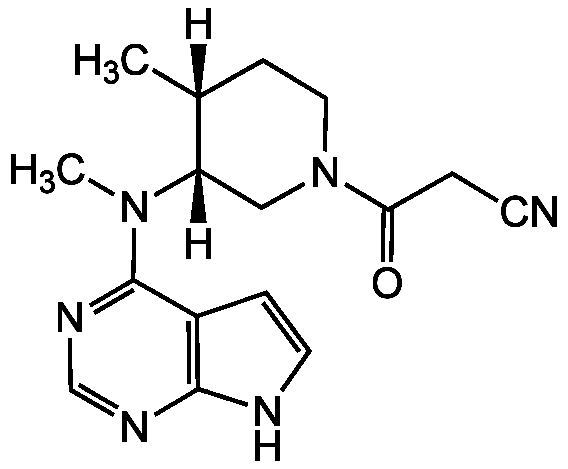
Chemical Structure
Tofacitinib [477600-75-2]

AG-CR1-3625
Overview
- SupplierAdipoGen Life Sciences
- Product NameTofacitinib [477600-75-2]
- Delivery Days Customer10
- ADR Class6.1
- CAS Number477600-75-2
- CertificationResearch Use Only
- Estimated Purity>98%
- Hazard InformationDanger,Excepted quantity
- Molecular FormulaC16H20N6O
- Molecular Weight312.4
- Scientific DescriptionChemical. CAS: 477600-75-2. Formula: C16H20N6O. MW: 312.4. Potent cell permeable JAK3 inhibitor (IC50 = 1nM). Shows also JAK-1 inhibitory activity. Immunosuppressive and anti-inflammatory agent. Inhibits signaling through heterodimeric receptors associated with JAK3, JAK1, or both of them, with functional selectivity over JAK2-paired receptors. Blocks downstream STAT signaling, resulting in potent inhibition of several cytokines, including interleukins 2, 4, 7, 9, 15 and 21, which are integral to lymphocyte activation, function and proliferation. Investigated for several autoimmune disorders including, rheumatoid arthritis and psoriasis. Potent and selective inhibitor of HIV-1 replication and virus reactivation in vitro. - Potent cell permeable JAK3 inhibitor (IC50 = 1nM). Shows also JAK-1 inhibitory activity. Immunosuppressive and anti-inflammatory agent. Inhibits signaling through heterodimeric receptors associated with JAK3, JAK1, or both of them, with functional selectivity over JAK2-paired receptors. Blocks downstream STAT signaling, resulting in potent inhibition of several cytokines, including interleukins 2, 4, 7, 9, 15 and 21, which are integral to lymphocyte activation, function and proliferation. Investigated for several autoimmune disorders including, rheumatoid arthritis and psoriasis. Potent and selective inhibitor of HIV-1 replication and virus reactivation in vitro. It is investigated against the spread of the SARS-CoV-2 (COVID-19). PRK1 inhibitor.
- SMILES[H][C@@]1(C)CCN(C[C@]1([H])N(C)C1=NC=NC2=C1C=CN2)C(=O)CC#N
- Storage Instruction-20°C,2°C to 8°C
- UN NumberUN 2811
- UNSPSC12352200
References
- Prevention of organ allograft rejection by a specific Janus kinase 3 inhibitor: P.S. Changelian, et al.; Science 302, 875 (2003)
- Immunosuppression by the JAK3 inhibitor CP-690,550 delays rejection and significantly prolongs kidney allograft survival in nonhuman primates: D.C. Borie, et al.; Transplantation 79, 791 (2005)
- Combined use of the JAK3 inhibitor CP-690,550 with mycophenolate mofetil to prevent kidney allograft rejection in nonhuman primates: D.C. Borie, et al.; Transplantation 80, 1756 (2005)
- The JAK-3 inhibitor CP-690550 is a potent anti-inflammatory agent in a murine model of pulmonary eosinophilia: E. Kudlacz, et al.; Eur. J. Pharmacol. 582, 154 (2008)
- CP-690550, a JAK3 inhibitor as an immunosuppressant for the treatment of rheumatoid arthritis, transplant rejection, psoriasis and other immune-mediated disorders: K. West; Curr. Opin. Investig. Drugs 10, 491 (2009) (Review)
- Discovery of CP-690,550: a potent and selective Janus kinase (JAK) inhibitor for the treatment of autoimmune diseases and organ transplant rejection: M.E. Flanagan, et al.; J. Med. Chem. 53, 8468 (2010)
- CP-690,550, a therapeutic agent, inhibits cytokine-mediated Jak3 activation and proliferation of T cells from patients with ATL and HAM/TSP: W. Ju, et al.; Blood 117, 1938 (2011)
- Modulation of innate and adaptive immune responses by tofacitinib (CP-690,550): K. Ghoreschi, et al.; J. Immunol. 186, 4234 (2011)
- Inhibitory effects of the JAK inhibitor CP690,550 on human CD4(+) T lymphocyte cytokine production: K. Migita, et al.; BMC Immunol. 12, 51 (2011)
- JAK inhibitor tofacitinib for treating rheumatoid arthritis: from basic to clinical: Y. Tanaka & K. Yamaoka; Mod. Rheumatol. 23, 415 (2013) (Review)
